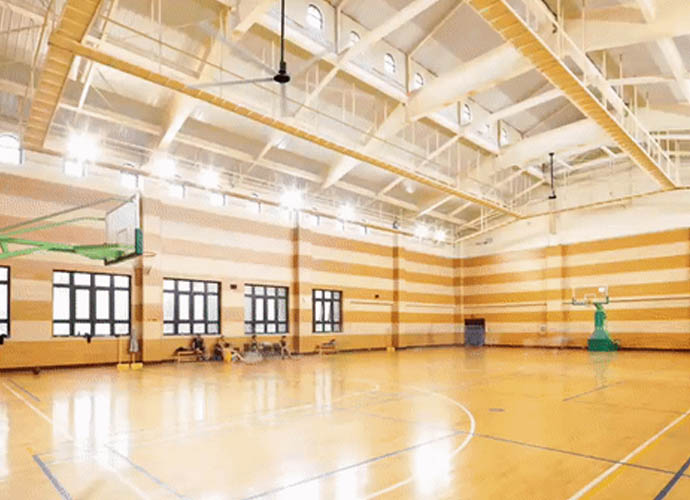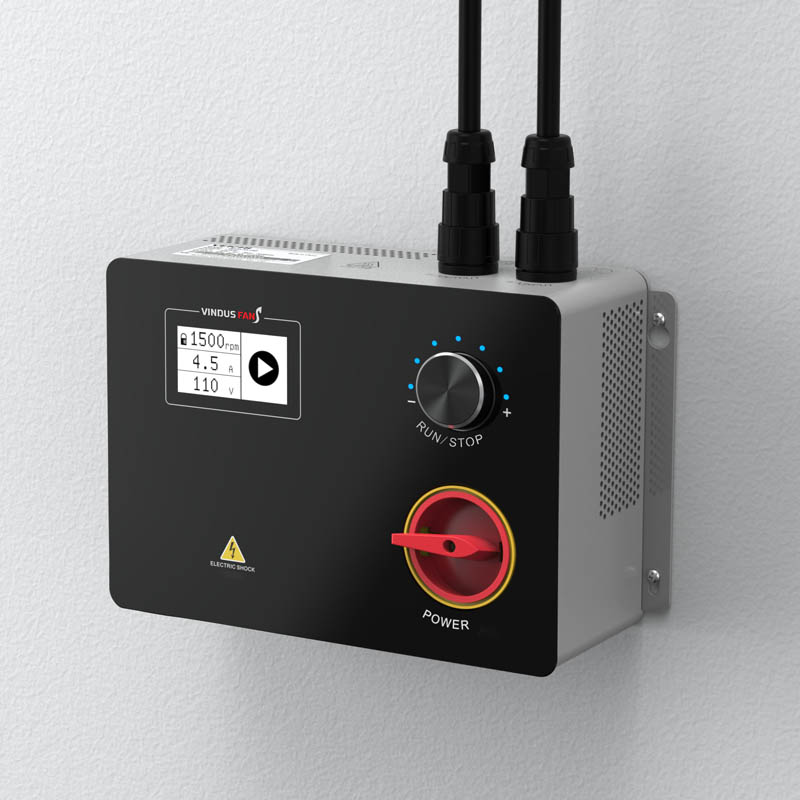Are hot, stale work areas slowing your team? Rising energy costs don’t help. Stagnant air makes people tired and machines unhappy. A properly sized hvls fan brings steady comfort, better mixing, and lower bills—without big changes to your building.
Answer in a nutshell: In factories and warehouse spaces, hvls fans move large volumes of air at low speeds, boosting comfort and air circulation, easing HVAC load, and delivering energy savings. That means steadier temperatures, better airflow, and money saved—especially when paired with your HVAC system for destratification and seasonal comfort in commercial and industrial buildings.
%Energy-Saving HVLS Fans for Factories
An hvls fan (high-volume, low-speed) is a big-diameter, slow-turning ceiling-mounted fan. Unlike small ceiling fans, an hvls fan sweeps a broad area and creates a gentle, laminar airflow that travels far. These low-speed fans destratify hot and cool layers, so temperatures even out across the space.
Mechanically, hvls fans are designed to push a high volume of air downward, then outward across the floor. The thin “river” of moving air skims surfaces and returns upward along the walls, so the fan can move a high volume repeatedly. In simple terms, fans are designed to move “a lot of air, very gently.”
Ready to see this in action? Explore the next-gen M650 series HVLS fans for engineering details and project photos.
Yes. Because hvls fans deliver wide, slow air movement, they keep people cool without drafts. The broad airflow pattern breaks up stagnant air pockets behind racking and machinery. That makes comfort more consistent—front to back, dock to mezzanine.
In summer, the perceived cool-ing effect lets you raise set points, while in winter, destratification evens the stack. Over long shifts, better comfort supports productivity and keeps operators focused.

Do HVLS fans really improve air circulation and airflow in large spaces?
When an hvls fan mixes air, your HVAC doesn’t work as hard to chase hot and cold spots. In cooling months you can bump set points and still feel cool. In heating months you recapture wasted ceiling heat. That’s how hvls fans save energy and reduce energy consumption.
This produces real energy savings by trimming compressor runtime and burner cycles. In dollar terms, hvls fans can help reduce peaks and cut energy costs. Over time, many sites see lower energy bills and smoother temperature control that maximize energy performance and overall energy efficiency.
“We installed five units in our assembly hall and saw steadier temperatures within a week.” — Plant Facilities Manager
Common applications of HVLS fans include packaging lines, machining cells, and paint areas in a factory, plus aisles and docks in a warehouse. In these industrial spaces, fans help move air around obstructions and address stratification above busy floor zones.
They also shine in commercial spaces like sports centers and showrooms where comfort must feel even and cool without noise. See guidance tailored to industrial ceiling fans for manufacturing projects Und warehouse HVLS fans applications to match layouts and ceiling heights.
Think first-order and second-order returns. First, the financial benefits of HVLS fans show up as energy savings from set-point adjustments and less cycling. Second, better comfort lifts productivity and helps retention by keeping teams comfortable in busy zones.
A simple rule of thumb: a single HVLS fan that serves a wide bay costs less to run than multiple small units. Over a year, an optimized mix of hvls fan plus HVAC can significantly reduce energy costs and reduce energy costs without sacrificing comfort.
Example numbers (illustrative):
| Szenario | Set-Point Change | Estimated Impact |
|---|---|---|
| Cooling season with hvls fan | +2 °C | 10–15% energy savings |
| Heating season with hvls fan | –1 °C | 10–20% energy savings |
Air mixing helps reduce humidity pockets that cause corrosion and condensation on tools. By moving air at low levels under racks and mezzanines, hvls fans provide steadier conditions, reducing rust risk and minor slips.
Better mixing also improve air quality by reducing stagnant air zones where fumes linger. In process-heavy manufacturing facilities, smoother airflow supports capture systems so fans can improve worker comfort while exhaust does its job.
Yes. HVLS fans complement packaged rooftops, make-up air, and unit heaters. When fans operate at low speeds they destratify gently, limiting drafts and not “fighting” supply diffusers. Your HVAC system then reads more stable return temperatures, which can reduce energy use.
In commercial and industrial settings, smart controls coordinate fans with set points, so fans operate when they help most. The result? Smoother comfort and less energy usage across seasons.
For design inspiration in arenas and gyms, see commercial ceiling fans for sports-centers solutions that pair fans and HVAC without conflict. Sports-center guidance outlines typical placements around courts and tracks.

Die besten Fans im Sportzentrum
Sizing balances diameter, rpm, and location. Bigger fan blades at low rotational rpm create a wide, gentle “air river.” Choose a large fan when you need coverage across open bays and tall racking.
Because hvls fans deliver volumes of air at low rpm, they can cover long aisles. In large facilities, place the hub near the thermal center and avoid obstructions. This is where hvls industrial ceiling fans excel over spot coolers.
If your site mixes retail floors and lobbies, review big commercial ceiling fans for commercial-building layouts for spacing and controls that match visitor traffic.
An industrial ceiling fan (especially an hvls fan) covers long throws with gentle air movement. Traditional ceiling fans are fine for small rooms but lack reach over racks and machinery. Floor fans help spot-cool tasks but can clutter aisles and create noise.
When you compare an industrial fan lineup, consider: coverage area, rpm, control zones, and integration with building ventilation. In many industrial environments, one hvls fan outperforms clusters of small ceiling fans.
Modern hvls fan technology includes redundant safety cables, hub bolts, blade clamps, and fault detection. These fans are built for 24/7 duty in dusty industrial environments, with sealed gearboxes or direct drives and robust mounts for concrete or steel trusses.
Controls matter. Networked drives, BMS tie-ins, and occupancy logic ensure hvls fans only run when needed—helping reduce energy while keeping people cool. For heavy-duty sites and large industrial spaces, see project-proven große Industrieventilatoren für die Fertigung configurations and recommended control packages.

M750 Series HVLS Fan controller
A Midwest plant added a single HVLS fan over a manual assembly area. Before, uneven temperatures and stagnant air sapped productivity on hot days. After install, staff reported steady cool comfort and fewer breaks to step off the line.
Measured results: fewer hot complaints, tighter temperature spread, and significant energy savings from a slightly higher cooling set point. The takeaway? Smart hvls fan placement can save energy while keeping people focused.
Environmental benefits of HVLS fans are simple: they make existing systems smarter. A well-programmed hvls fan helps reduce energy consumption, supporting corporate sustainability goals. Pairing fans with electrified heating or cooling upgrades compounds gains.
Because hvls fans can also serve shoulder seasons without compressor use, they offer low-cost ways to keep teams cool and reduce runtime. That’s energy saving you can measure, season after season.
Look for engineering depth, field experience, and proven service. Review blade aerodynamics, hub design, drive choice, and control logic. The best partners offer layout support for industrial and commercial spaces, commissioning, and long warranties.
Start with a team that focuses on commercial fans for industrial spaces. We manufacture hvls fan solutions for factories, warehouses, gyms, schools, and logistics. See our About us: HVLS fans manufacturer to review in-house design and project support, or browse the M750 series HVLS fans for high-ceiling bays.
| Besonderheit | HVLS-Ventilator | Kleine Deckenventilatoren | Spot floor fans |
|---|---|---|---|
| Abdeckung | Very wide | Klein | Local only |
| Perceived comfort | Gentle, even, cool | Local | Drafty |
| Integration | BMS/HVAC friendly | Manual | Manual |
| Aisle clutter | Keine | Keine | Can obstruct |
| Typical outcome | HVLS fans can help reduce hot/cold spots | Limited reach | No destratification |
Assumptions (illustrative): One 7.3 m hvls fan serving two bays.
Simple ASCII “comfort” bar (illustrative):
Before : ████████████ (hot ceilings, cold floor)
After : ████████████ (more even from floor to roof)
For commercial and industrial lobbies, showrooms, and multi-tenant areas, get spacing and mounting tips from the commercial building application guide. For sports halls and arenas, review the sports-center fan layouts.
How do HVLS fans make people feel cooler without turning the AC lower?
They create gentle air movement that increases evaporation from skin. People feel cool even when the thermostat is higher. That effect is why fans can help comfort while you save energy.
Will HVLS fans work with my existing rooftop units and ducted system?
Yes. With proper controls, fans mix air so your HVAC reads steadier returns. That helps the HVAC system keep temperatures even and can reduce energy use.
Can HVLS fans help with fumes or dust?
They don’t replace capture systems, but by evening out flow and breaking stagnant air, hvls fans can improve air mixing so filtration and exhaust perform better and improve air quality overall.
Are HVLS fans loud?
No. Because they move air at low speeds, sound levels stay comfortable. The goal is a quiet “river of air,” not a gust.
What about brand differences—do they matter?
Yes. Blade design, hub strength, and controls matter. In industry spec sheets you’ll see terms like “hunter industrial” or “hunter industrial fans” class products; use them as reference points when comparing hvls fan performance and warranties.
How do HVLS fans perform in gyms, schools, and public venues?
Very well. They serve large commercial areas and maintain comfort during events. For examples, see sports-center projects.
Benefits of installing HVLS fans go beyond comfort. They deliver even conditions, smoother ventilation, and significant energy savings with a simple retrofit. Whether you manage commercial and industrial campuses or retrofit bays, hvls fans are a practical lever to cut energy costs and raise productivity.
If you’re planning a rollout, start with a pilot. Map the air, choose diameter, and verify coverage. Then scale to priority bays and docks. For industrial and commercial spaces, it’s a fast path to comfort that pays back.
Helpful internal references used for links:

Hallo, ich bin Michael Danielsson, CEO von Vindus Fans, mit über 15 Jahren Erfahrung in der Ingenieur- und Designbranche. Ich bin hier, um mein Wissen weiterzugeben. Wenn Sie Fragen haben, können Sie mich jederzeit kontaktieren. Lassen Sie uns gemeinsam wachsen!